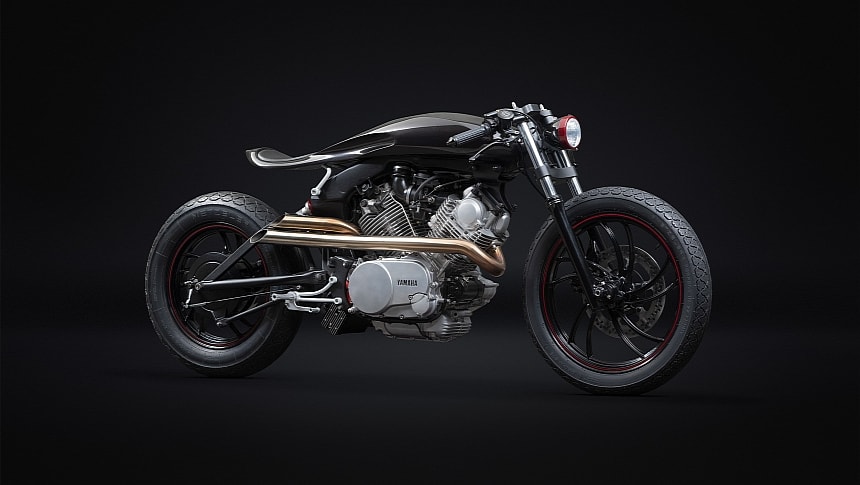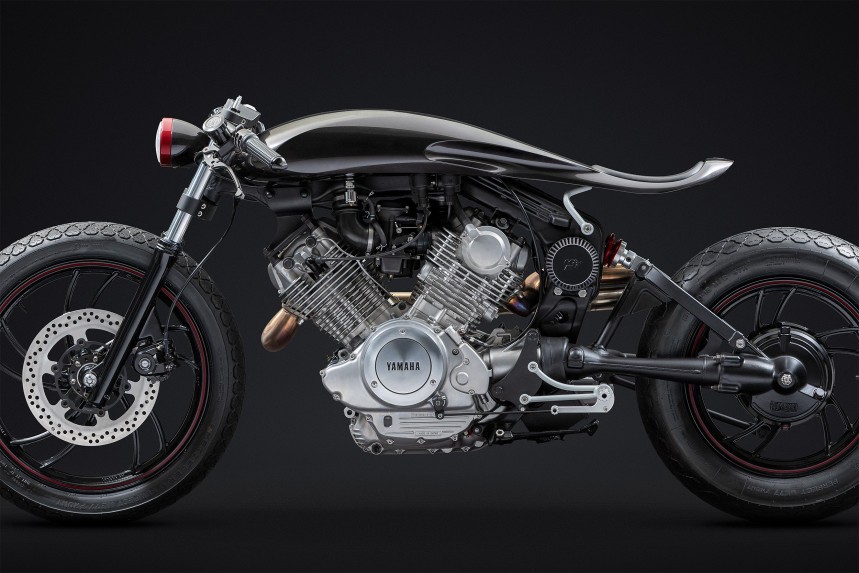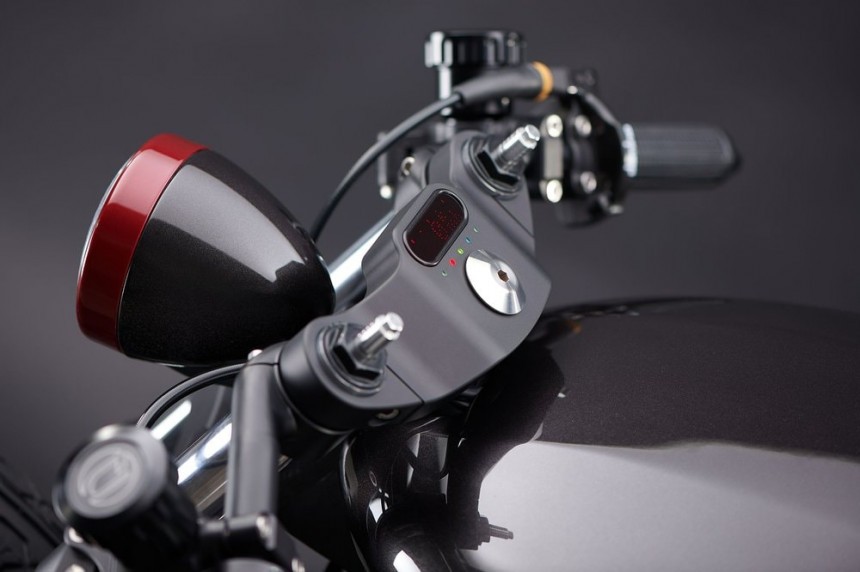Based in the quaint Slovak town of Stara Tura, Earth Motorcycles is one of those lesser-known custom bike workshops that could easily hang with the big boys. The firm is a two-man endeavor run by Vlado Dinga and Ales Tomis, with the former being its founder and primary decision-maker. We’ve already witnessed what these two are able to pull off, and calling their projects impressive would be a bit of an understatement.
Neo-retro styling is a defining feature on just about all their builds, but that’s not to say any of them are even remotely alike. Dubbed Fujara, the jaw-dropping cafe racer we’re about to look at is among the raddest machines pieced together by Vlado and his teammate. The guys clearly wanted to challenge themselves with this particular project, because they chose a Yamaha XV920 Virago as their starting point.
Although the 1984-model XV was a pretty solid foundation from a mechanical standpoint, its anatomy was far from ideal to say the least. The Earth Motorcycles duo had a lot of tweaking to do before the old Yamaha could look the way it does today, and the first step involved deleting a large chunk of its factory paraphernalia. Of course, that included all the stock bodywork once worn by the bulky Virago.
Many other bits and pieces followed suit, leaving Ales and Vlado with a blank canvas ready to be customized. Penning the design concept was the next port of call, and this is where Earth’s specialists needed some reinforcements. They reached out to industrial designer Konstantin Laskov over in Bulgaria, with plenty of cool ideas shot back and forth.
Eventually, they settled on a slim monocoque concept for the upper bodywork, one which would stand in stark contrast to the Virago’s beefy V-twin engine. With the physical sketches complete, the design was translated into a digital 3D rendering before the fabrication work could get underway. Molds were meticulously carved out, and the final piece was ultimately shaped out of fiberglass.
Its rearmost section is supported by a plain custom subframe and topped with a small seat pad, both of which were fabricated in-house by the Slovak dream team. The saddle doesn’t offer much in the way of comfort, but it does excel at keeping the bike’s silhouette as clean as possible. Further ahead, a flush-mounted filler cap has been installed to serve a similar purpose, and the result is sano.
A trio of tiny LEDs are integrated into the tail section at the back, without messing up its contour in any way. Further showcasing the shop’s attention to detail are the handmade rearsets placed lower down, as they seamlessly echo the subframe’s design right down to the mounting points. Of course, the bespoke sorcery continues to shine at the front, where we still find the original telescopic forks.
They’ve been shortened to get the motorcycle’s stance just right, and the stock triple clamps have been replaced with CNC-machined billet aluminum parts. The upper unit comes equipped with LED warning lights and a digital aftermarket dial from Motogadget’s catalog. In addition, Fujara’s cockpit area is also home to clip-on handlebars with premium clutch and brake master cylinders. Motogadget grips, compact switches, and bar-end turn signals are present, as well.
However, there are no rear-view mirrors in sight, because Earth Motorcycles didn’t mind sacrificing some practicality for the sake of aesthetics on this build. Right in front of the cockpit area, the lads fitted a small headlight sporting a clear retro-looking lens. Interestingly enough, they chose to keep the Virago’s OEM wheels in play, only revising their spokes ever so slightly to achieve the desired look.
The rims were enveloped in Metzeler rubber fore and aft, packing plentiful grip as well as great looks. On the performance front, the Yammie was blessed with a complete overhaul of its V-twin powerplant, before gaining some fresh breathing equipment at both ends of the combustion cycle. Air flows in through a K&N pod filter, but the exhaust side of things is even more enticing.
Vlado and Ales fashioned the gorgeous stainless-steel pipework from scratch, making it perfectly horizontal to contrast against the curvy bodywork. The exhaust tips line up with the swingarm brace in seamless fashion, and the whole ordeal is what led to the bike’s nickname. A fujara is a traditional Slovak flute primarily used by shepherds, though Earth Motorcycles’ design decisions get downright philosophical.
The monocoque attire’s undulating lines are meant to represent the wind, while the straight exhaust system symbolizes the earth. Lastly, Fujara received a coat of black paint on items like the wheels, bodywork, and swingarm, along with snazzy red accents in various places. A nice bit of bare metal also makes an appearance, most notably on the specimen’s engine covers. All things considered, the Slovaks really outdid themselves on this project in more than one way!
Although the 1984-model XV was a pretty solid foundation from a mechanical standpoint, its anatomy was far from ideal to say the least. The Earth Motorcycles duo had a lot of tweaking to do before the old Yamaha could look the way it does today, and the first step involved deleting a large chunk of its factory paraphernalia. Of course, that included all the stock bodywork once worn by the bulky Virago.
Many other bits and pieces followed suit, leaving Ales and Vlado with a blank canvas ready to be customized. Penning the design concept was the next port of call, and this is where Earth’s specialists needed some reinforcements. They reached out to industrial designer Konstantin Laskov over in Bulgaria, with plenty of cool ideas shot back and forth.
Eventually, they settled on a slim monocoque concept for the upper bodywork, one which would stand in stark contrast to the Virago’s beefy V-twin engine. With the physical sketches complete, the design was translated into a digital 3D rendering before the fabrication work could get underway. Molds were meticulously carved out, and the final piece was ultimately shaped out of fiberglass.
A trio of tiny LEDs are integrated into the tail section at the back, without messing up its contour in any way. Further showcasing the shop’s attention to detail are the handmade rearsets placed lower down, as they seamlessly echo the subframe’s design right down to the mounting points. Of course, the bespoke sorcery continues to shine at the front, where we still find the original telescopic forks.
They’ve been shortened to get the motorcycle’s stance just right, and the stock triple clamps have been replaced with CNC-machined billet aluminum parts. The upper unit comes equipped with LED warning lights and a digital aftermarket dial from Motogadget’s catalog. In addition, Fujara’s cockpit area is also home to clip-on handlebars with premium clutch and brake master cylinders. Motogadget grips, compact switches, and bar-end turn signals are present, as well.
The rims were enveloped in Metzeler rubber fore and aft, packing plentiful grip as well as great looks. On the performance front, the Yammie was blessed with a complete overhaul of its V-twin powerplant, before gaining some fresh breathing equipment at both ends of the combustion cycle. Air flows in through a K&N pod filter, but the exhaust side of things is even more enticing.
Vlado and Ales fashioned the gorgeous stainless-steel pipework from scratch, making it perfectly horizontal to contrast against the curvy bodywork. The exhaust tips line up with the swingarm brace in seamless fashion, and the whole ordeal is what led to the bike’s nickname. A fujara is a traditional Slovak flute primarily used by shepherds, though Earth Motorcycles’ design decisions get downright philosophical.
The monocoque attire’s undulating lines are meant to represent the wind, while the straight exhaust system symbolizes the earth. Lastly, Fujara received a coat of black paint on items like the wheels, bodywork, and swingarm, along with snazzy red accents in various places. A nice bit of bare metal also makes an appearance, most notably on the specimen’s engine covers. All things considered, the Slovaks really outdid themselves on this project in more than one way!






















